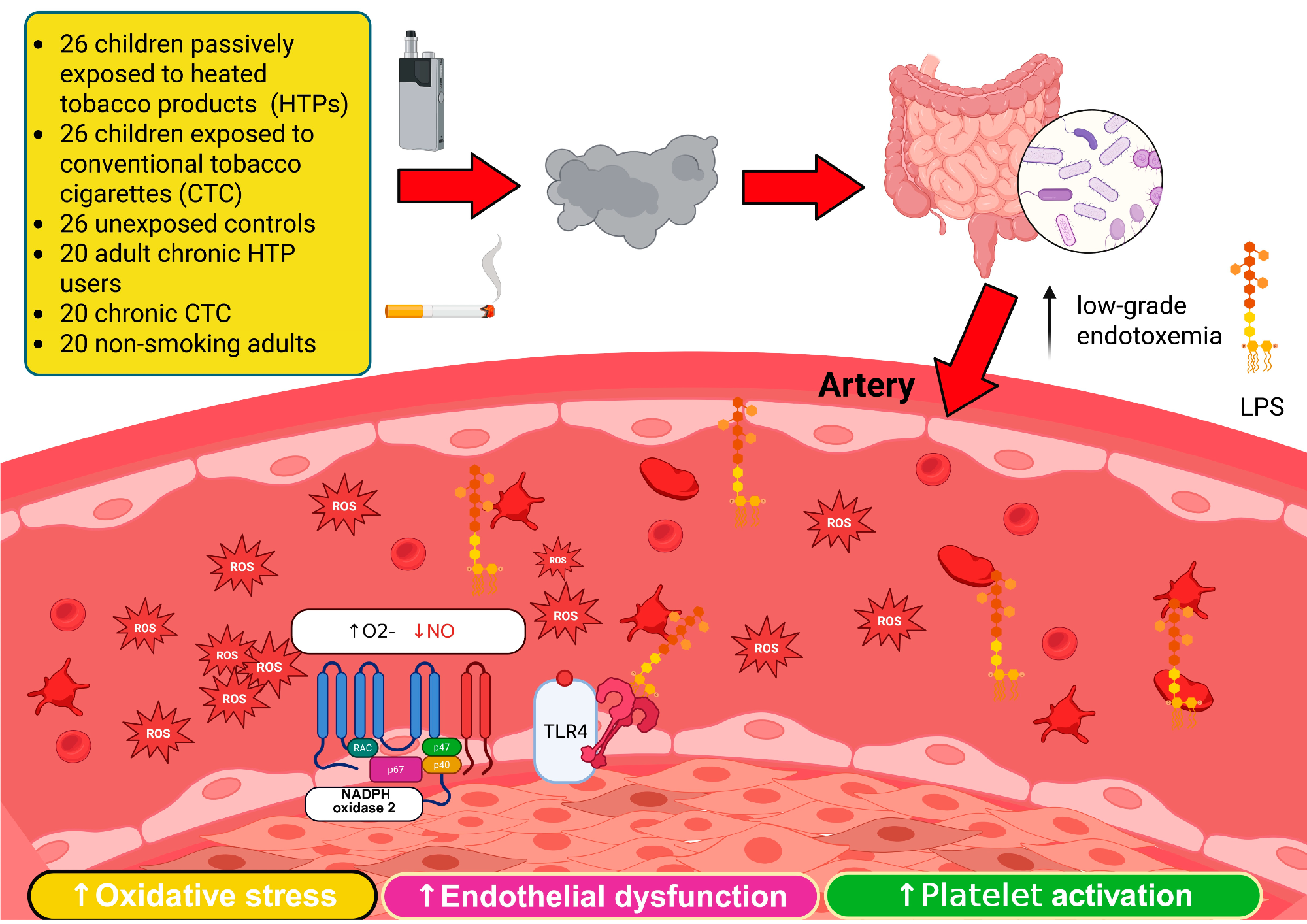Both traditional and heated tobacco exposure, whether active or passive, were linked to intestinal permeability, oxidative stress, and endothelial dysfunction, revealing that “smokeless” doesn’t mean harmless.

Review: Tobacco Smoke Exposure and Oxidative Stress: The Role of Circulating Lipopolysaccharides in Heated and Conventional Products
In a recent article in the journal Antioxidants, researchers in Italy investigated the effects of tobacco smoke exposure on endothelial dysfunction and oxidative stress. They found that adults and children who were exposed to tobacco smoke, either from heated tobacco products (HTPs) or conventional cigarettes, showed markers of oxidative stress and endotoxemia. Unlike electronic cigarettes, which vaporize nicotine-containing liquids, HTPs heat real tobacco at lower, non-combustion temperatures to generate a tobacco aerosol, making them chemically and biologically distinct from vapes.
Global Health Impact of Tobacco Use
Tobacco use remains a leading preventable cause of disease and death worldwide, mainly due to its connection to cardiovascular disease and cancer. Conventional cigarettes emit a range of toxic compounds that trigger systemic inflammation and chronic health problems.
Manufacturers promote HTPs as “safer alternatives,” claiming reduced harmful emissions because of lower heating temperatures. However, emerging data suggest that HTPs still cause oxidative stress and vascular injury similar to traditional cigarettes.
Endotoxemia as a Mechanism of Tobacco-Induced Damage
One central mechanism underlying tobacco-related harm is endotoxemia, characterized by elevated lipopolysaccharide (LPS) levels resulting from the presence of Gram-negative bacteria in the bloodstream. Smoking disrupts gut microbiota and weakens the intestinal barrier, allowing LPS to enter circulation. Smoke particles themselves may also carry endotoxins.
Circulating LPS activates Toll-like receptor 4 (TLR4), promoting inflammation and oxidative stress through the activation of NADPH oxidase 2 (NOX2). This cascade links intestinal permeability with systemic oxidative stress and endothelial injury observed in both adults and children.
Sources of Endotoxemia and Oxidative Pathways
While the relationship between endotoxemia and vascular injury is correlational rather than causal, endotoxins may originate not only from the gut but also from the lungs or oral cavity. The reactive oxygen species generated through NOX2 activation impair endothelial function and heighten cardiovascular risk.
Increased Vulnerability in Children to Smoke Exposure
Children exposed to second-hand smoke may be particularly susceptible to oxidative and vascular damage. Comparative data on endotoxemia and NOX2 activation between adults and children exposed to either conventional or heated tobacco remain scarce. The Italian study aimed to fill these gaps by evaluating LPS levels and related oxidative and vascular biomarkers in these populations.
Study Design: Comparing Children and Adults
Researchers used a cross-sectional study design involving both children passively exposed to tobacco smoke and adults who actively used conventional cigarettes or HTPs. The primary goal was to measure serum LPS levels, with secondary analyses exploring oxidative stress, endothelial dysfunction, and platelet activation.
The child cohort included 78 participants (aged 2–18): 26 passively exposed to HTPs, 26 to conventional cigarettes, and 26 unexposed controls. The adult cohort comprised 60 participants: 20 chronic HTP users, 20 smokers, and 20 non-smokers. All HTP users had previously smoked conventional cigarettes.
Laboratory Analyses and Statistical Methods
Fasting blood samples were collected to measure LPS, oxidative stress markers (NOX2-derived peptide, hydrogen peroxide, and isoprostanes), endothelial function (nitric oxide levels and flow-mediated dilation), and intestinal permeability (zonulin). Serum cotinine verified tobacco exposure.
Statistical testing involved ANOVA or non-parametric tests, correlation analysis, and multivariate regression adjusted for age, sex, BMI, and cotinine.
Endotoxemia and Oxidative Stress Findings
Both passive and active exposure to tobacco smoke, whether from HTPs or cigarettes, were linked to increased endotoxemia and intestinal permeability. Among children, serum LPS and zonulin were significantly elevated in both HTP- and cigarette-exposed groups compared with controls, showing no significant difference between exposure types.
LPS correlated positively with cotinine, zonulin, and platelet activation markers (sCD40L, P-selectin) and negatively with antioxidant capacity (HBA). Cotinine and zonulin emerged as independent predictors of LPS, reinforcing the connection between nicotine exposure, gut permeability, and oxidative stress.
Adult Cohort Results: Endothelial Dysfunction and Barrier Disruption
In adults, both HTP users and cigarette smokers exhibited elevated LPS and zonulin levels compared to non-smokers, with no significant difference between the two groups. LPS correlated positively with zonulin, NOX2, hydrogen peroxide, and platelet activation markers but negatively with nitric oxide, evidence of endothelial dysfunction.
Regression models identified zonulin and nitric oxide bioavailability as key predictors of LPS, underscoring the intertwined nature of gut barrier disruption and vascular stress.
Implications for Tobacco Harm Reduction Claims
The findings demonstrate that both HTPs and cigarettes, whether actively used or passively inhaled, promote low-grade endotoxemia linked to oxidative stress and vascular impairment. This challenges industry claims that HTPs are meaningfully safer alternatives to traditional smoking.
Study Limitations and Public Health Implications
This study provides the first evidence connecting HTPs and cigarette exposure to elevated circulating LPS and zonulin in both children and adults, implying intestinal barrier dysfunction and cardiovascular risk. While comprehensive in scope, the study’s small sample size, lack of microbiome data, and absence of mechanistic experimentation limit the ability to draw causal conclusions. Prior cigarette use among HTP users could also confound results.
The authors further note that HTP aerosol temperatures can still reach levels sufficient for nicotine pyrolysis, potentially eliciting similar oxidative responses to those from combustible cigarettes. Nicotine exposure itself may exacerbate gut permeability and dysbiosis, amplifying oxidative stress.
Conclusion: Equal Risk from Heated and Conventional Tobacco
In conclusion, both HTPs and conventional cigarettes impair gut barrier integrity and increase cardiovascular risk, refuting claims of reduced harm. The results highlight the urgent need for stronger tobacco control policies and targeted public health interventions to protect both smokers and those exposed to second-hand smoke.
Journal reference:
- Loffredo, L., Maggio, E., Bartimoccia, S., Magna, A., Totè, C. M., Bagnato, C., Cinicola, B. L., Armeli, F., Leonardo, A., D’Amico, A., Greco, E., Frati, G., Biondi-Zoccai, G., Spalice, A., Angeloni, A., Pignatelli, P., Violi, F., Zicari, A. M., Carnevale, R., Smoking Prevention Group. (2025). Tobacco Smoke Exposure and Oxidative Stress: The Role of Circulating Lipopolysaccharides in Heated and Conventional Products. Antioxidants, 14(11), 1316. DOI: 10.3390/antiox14111316, https://www.mdpi.com/2076-3921/14/11/1316